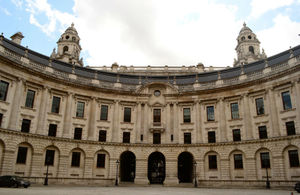Four treasures worth £29 million saved for the nation in 2011/12
Four national treasures worth over £29 million in total were saved from leaving the country in the last year and purchased for public collections.

They are highlighted in the 58th annual report of the Reviewing Committee on the Export of Works of Art and Objects of Cultural Interest (Reviewing Committee), published today.
The four items which have been acquired by British institutions for the public to access and enjoy are:
- Portrait of Mademoiselle Claus by Edouard Manet, acquired by the Ashmolean Museum in Oxford (worth £28,350,000 but bought for £7,830,000 after tax remission)
- Benjamin Britten’s complete draft score of The Young Person’s Guide to the Orchestra which was purchased by the British Library for £201,660 after tax remission (original cost of £220,000)
- a pair of Italian console tables, one purchased by the Victoria & Albert (V&A) Museum, and one by National Museums Scotland (£367,950 each)
- The Crouching Venus, a sculpture by John Nost the Elder, which was acquired by the V&A (£485,000)
Lord Inglewood, Chairman of the Reviewing Committee, said:
It is very encouraging that, thanks to tax relief, institutions had to raise just under £9.3 million in order to purchase items worth over £29 million. This shows the benefits that can arise from the workings of a tax system which encourages the retention of treasures like these in this country. I would encourage the Treasury to look sympathetically and constructively at how the nation in the future can benefit even more from such schemes.
Most cultural objects over 50 years of age, and valued above certain thresholds, require a licence for export out of the UK, whether on a permanent or temporary basis. Where the object has been in the UK for 50 years or more, the Reviewing Committee, administered by Arts Council England, review these items against the three Waverley Criteria, which are used to assess whether the object is of national importance.
Where the Committee finds that an object meets one or more of the criteria, it will normally recommend to the Secretary of State for Culture, Media and Sport that the decision on the export licence application should be deferred for a specified period. The Secretary of State can then place a temporary export bar on the item, giving museums, galleries, libraries and private individuals in the UK time to raise the necessary funds to purchase it.
Between 1 May 2011 and 30 April 2012, eleven items were considered by the Reviewing Committee, seven of which were referred to the Secretary of State. The seven items cover a diverse range of fields, from fine art, to a draft score by one of Britain’s most famous composers. Four items were bought by public institutions. Matching funds could not be raised for paintings by Watteau, Guardi and an early 19th century Italian classical tripod (see notes to editors).
Alan Davey, Chief Executive, Arts Council England, said:
It is wonderful that these rare and beautiful objects have been saved for the nation and are available for everyone to enjoy.
This wouldn’t have been possible without the support of the Heritage Lottery Fund, The Art Fund and various other charitable trusts - and, of course, individual donations from people across the UK.
That so many individuals made donations shows the value that people in this country place on art and culture; that they believe our cultural heritage is something worth preserving and investing in.
Ed Vaizey, Culture Minister, said:
It’s fantastic that these four treasures are now on permanent public display in the UK and I congratulate all those involved in the fundraising efforts to keep them in Britain. The export licensing system is a valuable tool in preventing items like these from disappearing abroad and ensuring they will be enjoyed for generations to come.
The Reviewing Committee is an independent body, serviced by the Acquisitions, Exports, Loans and Collections Unit (AELCU) of Arts Council England. The AELCU safeguards and enriches the cultural property of the nation by:
- awarding Accreditation and Designation to museums and collections
- administering Government Indemnity which provides a no-cost alternative to insurance for loans on public exhibition
- recommending which vital works of art and items of cultural significance should remain in the country
- advising on the acceptance and allocation of cultural objects in lieu of inheritance tax
Notes to Editors
-
Images of the four items are available on our flickr account:
Crouching Venus sculpture
Baroque tables
Manet - Portrait of Mlle Claus
Britten manuscript - For more information contact:
Sam Gough, Media Relations Officer (Museums and Libraries), Arts Council England, Tel: 020 7973 5189 or 07872 416 679
Email: sam.gough@artscouncil.org.uk - Matching funds could not be raised for three items found to be of outstanding significance. The fair matching price at which each item was deferred is given in brackets. A painting by Jean-Antoine Watteau, La Surprise (£17,500,000), a painting by Francesco Guardi, Venice: A View of the Rialto Bridge from the Fondamenta del Carbon (£26,697,250) and a North Italian Athenienne by Luigi Manfredini (£632,940)
- Arts Council England champions, develops and invests in artistic and cultural experiences that enrich people’s lives. It supports a range of activities across the arts, museums and libraries - from theatre to digital art, reading to dance, music to literature, and crafts to collections. Between 2011 and 2015, ACE will invest £1.4 billion of public money from government and an estimated £1 billion from the National Lottery to help create these experiences for as many people as possible across the country.
Press Enquiries: 020 7211 2210
Out of hours telephone pager no: 07699 751153
Public Enquiries: 020 7211 6000